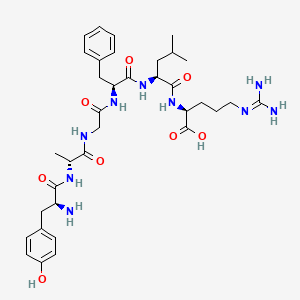



1. 2-ala-6-arg-leu-enkephalin
2. Enkephalin, Ala(2)-leu(5)-arg(6)-
3. Enkephalin-leu, Ala(2)-arg(6)-
4. Enkephalin-leu, Ala(2)-arg(6)-, (d-arg-l-tyr-d-ala-l-phe-d-leu)-isomer
5. Enkephalin-leu, Ala(2)-arg(6)-, (d-arg-l-tyr-d-ala-l-phe-l-leu)-isomer
6. Enkephalin-leu, Ala(2)-arg(6)-, (l-arg-l-tyr-d-ala-l-phe-d-leu)-isomer
7. Enkephalin-leu, Alanyl(2)-arginine(6)-
8. Leu-enkephalin, Ala(2)-arg(6)-
9. Leucine-enkephalin, Ala(2)-arg(6)-
10. Tageflar
11. Tyr-ala-gly-phe-leu-arg
12. Tyrosyl-alanyl-glycyl-phenylalanyl--leucyl-arginine
1. 81733-79-1
2. Tyr-d-ala-gly-phe-leu-arg
3. (2s)-2-[[(2s)-2-[[(2s)-2-[[2-[[(2r)-2-[[(2s)-2-amino-3-(4-hydroxyphenyl)propanoyl]amino]propanoyl]amino]acetyl]amino]-3-phenylpropanoyl]amino]-4-methylpentanoyl]amino]-5-(diaminomethylideneamino)pentanoic Acid
4. Tageflar
5. V13505565p
6. Enkephalin-leu, Ala(2)-arg(6)-
7. (d-ala2)-leu-enkephalin-arg
8. Unii-v13505565p
9. (d-ala2)-leucine Enkephalin-arg
10. Dalargine
11. Brn 4287455
12. 2-d-alanine-1-6-beta-neoendorphin (human)
13. Dalargin [who-dd]
14. Tyrosyl-d-alanyl-glycyl-phenylalanyl-leucyl-arginine
15. Dtxsid50231302
16. 1-6-(d-ala2)-dynorphin
17. Ex-a5715
18. H-tyr-d-ala-gly-phe-leu-arg-oh
19. Zinc53255341
20. N(sup 2)-(n-(n-(n-(l-tyrosyl-d-alanyl)glycyl)-l-phenylalanyl)-l-leucyl)-l-arginine
21. 1-6-beta-neoendorphin (human), 2-d-alanine-
22. Q27291394
23. 1-6-.beta.-neoendorphin (human), 2-d-alanine-
24. L-arginine, L-tyrosyl-d-alanylglycyl-l-phenylalanyl-l-leucyl-
25. L-arginine, N(sup 2)-(n-(n-(n-(l-tyrosyl-d-alanyl)glycyl)-l-phenylalanyl)-l-leucyl)-
26. (2s,5s,8s,14r,17s)-17-amino-8-benzyl-2-(3-guanidinopropyl)-18-(4-hydroxyphenyl)-5-isobutyl-14-methyl-4,7,10,13,16-pentaoxo-3,6,9,12,15-pentaazaoctadecan-1-oic Acid
| Molecular Weight | 725.8 g/mol |
|---|---|
| Molecular Formula | C35H51N9O8 |
| XLogP3 | -2.5 |
| Hydrogen Bond Donor Count | 10 |
| Hydrogen Bond Acceptor Count | 10 |
| Rotatable Bond Count | 21 |
| Exact Mass | 725.38605962 g/mol |
| Monoisotopic Mass | 725.38605962 g/mol |
| Topological Polar Surface Area | 293 Ų |
| Heavy Atom Count | 52 |
| Formal Charge | 0 |
| Complexity | 1210 |
| Isotope Atom Count | 0 |
| Defined Atom Stereocenter Count | 5 |
| Undefined Atom Stereocenter Count | 0 |
| Defined Bond Stereocenter Count | 0 |
| Undefined Bond Stereocenter Count | 0 |
| Covalently Bonded Unit Count | 1 |
Adjuvants, Immunologic
Substances that augment, stimulate, activate, potentiate, or modulate the immune response at either the cellular or humoral level. The classical agents (Freund's adjuvant, BCG, Corynebacterium parvum, et al.) contain bacterial antigens. Some are endogenous (e.g., histamine, interferon, transfer factor, tuftsin, interleukin-1). Their mode of action is either non-specific, resulting in increased immune responsiveness to a wide variety of antigens, or antigen-specific, i.e., affecting a restricted type of immune response to a narrow group of antigens. The therapeutic efficacy of many biological response modifiers is related to their antigen-specific immunoadjuvanticity. (See all compounds classified as Adjuvants, Immunologic.)
Analgesics
Compounds capable of relieving pain without the loss of CONSCIOUSNESS. (See all compounds classified as Analgesics.)
Anti-Arrhythmia Agents
Agents used for the treatment or prevention of cardiac arrhythmias. They may affect the polarization-repolarization phase of the action potential, its excitability or refractoriness, or impulse conduction or membrane responsiveness within cardiac fibers. Anti-arrhythmia agents are often classed into four main groups according to their mechanism of action: sodium channel blockade, beta-adrenergic blockade, repolarization prolongation, or calcium channel blockade. (See all compounds classified as Anti-Arrhythmia Agents.)
Anti-Inflammatory Agents, Non-Steroidal
Anti-inflammatory agents that are non-steroidal in nature. In addition to anti-inflammatory actions, they have analgesic, antipyretic, and platelet-inhibitory actions. They act by blocking the synthesis of prostaglandins by inhibiting cyclooxygenase, which converts arachidonic acid to cyclic endoperoxides, precursors of prostaglandins. Inhibition of prostaglandin synthesis accounts for their analgesic, antipyretic, and platelet-inhibitory actions; other mechanisms may contribute to their anti-inflammatory effects. (See all compounds classified as Anti-Inflammatory Agents, Non-Steroidal.)
Anti-Ulcer Agents
Various agents with different action mechanisms used to treat or ameliorate PEPTIC ULCER or irritation of the gastrointestinal tract. This has included ANTIBIOTICS to treat HELICOBACTER INFECTIONS; HISTAMINE H2 ANTAGONISTS to reduce GASTRIC ACID secretion; and ANTACIDS for symptomatic relief. (See all compounds classified as Anti-Ulcer Agents.)
Antioxidants
Naturally occurring or synthetic substances that inhibit or retard oxidation reactions. They counteract the damaging effects of oxidation in animal tissues. (See all compounds classified as Antioxidants.)
Gastrointestinal Agents
Drugs used for their effects on the gastrointestinal system, as to control gastric acidity, regulate gastrointestinal motility and water flow, and improve digestion. (See all compounds classified as Gastrointestinal Agents.)
Sympatholytics
Drugs that inhibit the actions of the sympathetic nervous system by any mechanism. The most common of these are the ADRENERGIC ANTAGONISTS and drugs that deplete norepinephrine or reduce the release of transmitters from adrenergic postganglionic terminals (see ADRENERGIC AGENTS). Drugs that act in the central nervous system to reduce sympathetic activity (e.g., centrally acting alpha-2 adrenergic agonists, see ADRENERGIC ALPHA-AGONISTS) are included here. (See all compounds classified as Sympatholytics.)